Fleet impact force
Battleship is an abbreviation for a battleship. Battleship is the largest, most powerful and balanced in all respects warship among modern ships of other classes. The battleship was the strike force of the naval fleet from the XNUMXth century to the middle of the XNUMXth century.
The ship received its name due to the initial tactics of the use of battleships. Squadrons of the opposing sides came close to each other in the wake structure, i.e. lined up in a single line, after which a hot artillery duel began. Originally weapons The battleships were artillery. Subsequently, with progress in the field of naval weapons systems, the artillery weapons of battleships were supplemented with torpedo and mine weapons.
During its evolution, the class of battleships included many different subclasses. However, all these types of warships are still battleships. In this article we will analyze all the main stages of the development of a battleship, and also try to find out at what stage their evolution suddenly switched to those rails that ultimately led to the fact that battleships today completely disappeared from the composition of all military marine fleets of the world. Someone may object: the battleships were destroyed not by their supposedly incorrectly chosen appearance, but by the rapid development of naval weapons systems. In particular, submarines and mine-torpedo weapons, marine aviation and aviation weapons, guided missile weapons. There is something to answer to this seemingly obvious argument. Ships of other classes - minesweepers, mine-layers, landing ships, destroyers, cruisers, etc. - have not gone away and coexist quite well with these modern types of naval weapons, although they are much more vulnerable to it compared to even outdated battleships of the XNUMXth century. So what killed the battleships? We will try to find the answer to this question. This article may seem delusional to some, but someone, obviously, can find a rational kernel in it. To begin with, we consider the stages of the main classes of the battleship.
Sailing battleship
Appeared in the XVII century. Wooden three-masted ships with a displacement from 500 to 5000 t. As a rule, these ships constructively had three battery decks (from which they were called three-deck), on which ranged from 30 to 130 muzzle-loading guns of various calibers. The guns fired through the gun ports - special holes in the board. In a non-combat situation, the guns were usually pushed inside the hull, and the ports were closed with special semi-portals. Protection was provided by wooden boards of very large thickness. The premises for the commanders were concentrated in the stern of the vessel. Below the battery decks were cargo holds in which water supplies, provisions, as well as gunpowder and ammunition were stored. Sailing battleship was set in motion by sails, located on three masts. Naturally, he could move only with the presence of wind. With sufficient seaworthiness and autonomy, the speed capabilities of the sailing battleship left much to be desired. A typical representative of sailing battleships is HMS Viktory, Admiral Nelson’s flagship, which is still carefully preserved in Portsmouth. The domestic ship “The Twelve Apostles” is considered the most powerful sailing ship of the line.
Battery battleship
They were a further development of sailing battleships and were little different in their architecture. The ships with a displacement of 2000-10000 and length from 60 to 100 m. Their design was either combined or purely metal. In the case of a combined design, the base of the ship hull was wooden, and steel armor plates were hung on top of the wooden board in the most threatened areas. In the case of the metal structure, the entire hull of the ship was made of metal, and armor plates were an integral part of its rather simple structure. The ships had one battery deck, on which, by analogy with sailing battleships, artillery was located — up to 40, breech-loading or muzzle-loading guns of caliber, usually no more than 203 mm. At that stage, the composition of the ship artillery was quite muddled and had no logic in the matter of its tactical use. The composition of the armor was also quite primitive, and its thickness was about 100 mm. The power plant is a single-shaft piston steam driven coal fired machine. Allowed battery battleships to reach speeds from 8 to 14 knots. In addition, as a backup engine, there were still masts with sailing equipment. A good idea of this type of battleships is provided by HMS “Warrior”, which is parked in Portsmouth.
The battleship Warrior. Dimensions: 9358 t and 127х17,7 m. Armament: ten 179-mm (7 ”) guns, twenty-eight 68-pound guns, four 120-mm (4,7”) guns. Booking: board - 114 mm. Mobility: 1x5267 hp PM and 14 knots. (26 km / h). On sails - up to 13 bonds. (24 km / h). This ship differed from its combined wood-metal counterparts in a completely steel hull divided into double bottom 35 compartments. Also, this ship was of normal size to ensure proper seaworthiness and autonomy and to accommodate the necessary weapons and mechanisms.
Casemate battleship
These are the battleships of the period when the era of steam and armor began to enter its mature age: the 70 of the 19th century. Casemate battleships differed from battery battleships in an improved design, a sharp increase in the number of onboard mechanisms, devices and instruments, as well as a radical complication of their design. And although their size and displacement (around 10000 t and up to 110 m in length) did not change much in comparison with the largest battery battleships, the casemate battleships already completely outnumbered them in their combat potential. The principal differences were as follows. First, the caliber and the number of guns were standardized and began to have a clear classification in accordance with their performance characteristics and their intended use. On casemate battleships, all artillery was already divided into the main caliber (GK) and anti-mine caliber (MAP). The first was designed to destroy all types of surface targets and deliver artillery strikes on coastal targets, the second was intended to defeat attacking destroyers, destroyers, torpedo boats and other small-sized high-speed targets that could not catch the bulky artillery systems of the main caliber. As the main caliber, 4-8 heavy breech-loading or muzzle-loading guns of caliber from 240 mm to 340 mm were used. Small-caliber guns with a caliber up to 76 mm were used as a mine caliber. Such a composition of artillery was less numerous in comparison with artillery battery battleships, but was much more powerful and effective. The second innovation is the partial abandonment of the battery deck. The main caliber guns were now placed in individual casemates and were separated from the neighboring armored partitions. This significantly increased the survivability of such artillery in battle. The battery decks, if used now, only for the deployment of artillery of the PMK. Part of the artillery PMK began to be placed on the upper deck in the deck installations of circular rotation. In addition, the gigantic size and weight of new large-caliber guns, as well as ammunition for them, required the introduction of a partial or complete mechanization of the process of loading and pointing such a gun. For example, the 340-mm main-caliber gun compartment in the French casemate battleship Courbet was like a small mechanical plant. All this made it possible with full right to abandon at this stage the term "gun", replacing it with a more correct term in this case, "art installation" (AU). The gun ports of some dugout artillery mounts began to receive splinter protection. Changes have occurred in the design of the hull and in the elements of its protection. First, in order to increase survivability and unsinkability during battle and navigation damage, the battleships of this period began to receive a double bottom. Secondly, in order to counter the super-heavy “suitcases” of new large-caliber guns of the main caliber, the booking began to be pulled into relatively narrow belts, the thickness of which quickly reached 300 mm and more. The remaining parts of the hull either did not have protection at all, or had a purely symbolic protection. The power plant now included several steam piston machines operating on an 1 or 2 shaft. The maximum travel speed is up to 15-16 knots. Seaworthiness has become almost absolute (storm to 11 points). In addition, some of this type of battleships began to receive torpedo tubes with ammunition torpedoes and barrage mines. Such weapons already allowed to hit targets with artillery fire at a distance of 4-5 km and finally destroy them with torpedoes, if the target still retained buoyancy after shelling. The disadvantages of kazatelnogo battleships include very small angles of shelling of artillery installations of the Civil Code, their extremely low rate of fire (1 shot at 15-20 minutes), difficulty in using artillery in fresh weather, a primitive SLA fire control system.
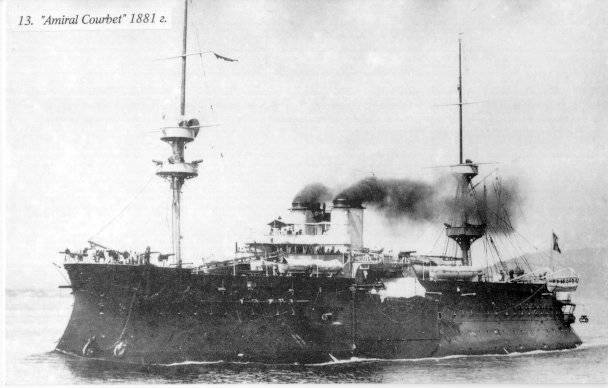
The casemate battleship Admiral Kurba in 1881. Naked power. At the time of entry into operation, probably caused a shiver from the lords of the British Admiralty. The board ended with an upper deck at a height of approximately 4-th floor of a multi-storey building, which made the seaworthiness of this imposing floating fortress almost absolute. Dimensions: 10450 m and 95h21,3 m Armament. Four 340-mm / L21 (13,4 ") M1881 and four 279-mm / L20 (10,8") M1875 UE HA six 140-mm (5,5 ") M1881 UE SC twelve 1 -pound guns PMK, five 356-mm TA. Reservations: board - up to 380 mm (wrought iron). Mobility: 2x4150 hp PM and 15,5 knots. (29 km / h). Obviously, such a technique will not fall apart and will not be drowned from a pair of hits by the PKP of the Exoset / Penguin / Outot / Harpoon type, etc., as it happens with modern high-tech warships, and its overall dimensions about the same (in length, even significantly less).
Tower battleship
The design flaws of the casemate battleships forced the designers to look for ways to increase the effectiveness of the use of the already quite solid firepower of the battleships. The solution was found - the creation of not casemate, and tower artillery installations of the main caliber, which were placed on the upper deck and had as a result much far greater angles of fire. In addition, a tower-mounted artillery unit is more protected than a casemate, although it is heavier. One- and two-gun turrets of the main caliber were built with guns of caliber from 240 mm to 450 mm. From one to three such installations were installed on the tower battleships (rarely more). Artillery SK and PMK continued to remain in the battery deck, in casemate and deck installations. Since the upper deck required space to accommodate huge installations, then the sailing armament was finally abandoned. Battleships now carried one or two masts, designed to accommodate observation posts, searchlights, small-caliber artillery and signaling equipment. The armor protection and powerplant remained at about the same level as the best casemate battleships. However, the number of support equipment for managing new, complex tower installations has become even greater. Two ships claim the title of the best tower battleships: the Italian battleship of the Duilio type and the domestic battleship Peter the Great.
The battleship "Duilio" is an armored monster with a displacement of 11138 tons. The main armament of the battleship was two two-gun gun mounts, placed diagonally in the center of the ship's hull. Each gun mount had two 450-mm muzzle-loading guns RML-17.72 weighing 100 tons each. Drives of loading and guidance mechanisms are hydraulic. They fired shells weighing almost a ton over a distance of 6 km and could pierce steel armor 1800 mm thick from a distance of 500 m. Rate of Fire - 1 salvo in 15-20 minutes. As the SK and PMK artillery, the ship had three 120-mm gun mounts and several small cannons. The picture is complemented by 3 torpedo tubes. In the stern there was a dock chamber for a torpedo boat of the Nomibio type. The ship had total mechanization of all work processes. The battleship Peter the Great anticipated the appearance of modern squadron battleships. Its architecture already complied with the canons, which shipbuilders adhere to at the present time. The main-caliber artillery is two-gun turrets with 305 mm / L20 guns. One unit was located at the bow, the second at the stern of a smooth-deck ship. This made it possible in the onboard salvo to use both gun mounts (all four guns), and also to act on the bow and stern with half of the artillery. In the center was a superstructure with logging, masts, pipes, combat posts and bridges. The firepower of the ship was complemented by two 229-mm mortars in the stern of the vessel. As artillery PMK used six 87-mm deck guns. Armor up to 365 mm. Reservation scheme improved. Speed up to 15 knots.
The battleship Dandolo is one of the Duililo battleships. It looks rather inconspicuous, however, in terms of the number of innovative technical solutions, the caliber of the GK guns and the level of mechanization, at one time was far ahead of the entire planet. Its drawbacks are poor seaworthiness and not very successful layout of weapons and control posts. Dimensions: 11138 t and 109,2x19,8 m. Armament: 2x2-450-mm / L20,5 (17,7 ”- shot with 908kg projectiles) RML-17.72 AU GK, three 120-mm (4,7”), a set aU ate aU a-10 aX aX aX, a-rk-356 AU GK, three 550-mm (50 ”) -mm TA, torpedo boat of the "Nomibio" type in the inner dock (on the "Duilio"). Reservations: board - up to 2 mm, deck - 3855 mm. Mobility: 15x28 hp PM and XNUMX knots. (XNUMX km / h). The “dreadnought” type of “all or nothing” protection of this ship made it possible to keep heavy single blows of large-caliber “suitcases” well, but it provided almost no protection against heavy fire of the UK and PMK from small and medium distances.
Barbet battleship
Constructively, they repeated the type of the battleship of the tower, but instead of the towers they had barbety. Barbet was a structure built into the hull of the ship in the form of a well of armor rings, in which the guns were located along with all the necessary mechanisms and instruments. The guns towering above the barbet were not a big target, and they were decided not to defend them. From above, such a construction was also not protected. Then the rotating part of the barbet artillery system received a light turret-like anti-splinter cover. In the process of evolution, the tower and the barbet gradually merged into a single structure, in which the barbet is the fixed part of the gun mount, and the tower crowning it with the guns is the moving rotating part. One of the most powerful barbetan battleships in the world were domestic Black Sea battleships of the Ekaterina-II type.
The monumental look of the Russian barbet battleship "George the Victorious" - one of a series of battleships of the "Catherine II" type (four ships). The fact that the photo is recognized as a classic artillery tower installation is actually a two-gun barbet installation of the main caliber with a light splinterproof cover. The first step is to merge the turret and barbet artillery layout together. Dimensions: 11032 m and 103,5h21 m Armament. 3h2-305-mm / L35 (12 ") AU HA seven 152-mm / L35 (6") AU SC, eight 47-mm and ten 37-mm UE PMK, 7 - 381 mm TA. Reservations: board - up to 406 mm, deck - up to 63 mm (iron). Mobility: 2x4922 hp PM and 16,5 knots. (31 km / h).
Monitor
Option flat-bottomed armadillo for action in shallow water. They had a flat hull with minimal draft and a very small freeboard. Add-ons are minimized. As one of the main weapons - one or two turret gun installations. The caliber of their guns could reach 305 mm and even more. As a rule, there were no other weapons, although there could still be a few small cannons. The power plant allows you to pick up speed 10-12 knots. Such ships were conditionally seaworthy and were intended for actions maximum in the near sea zone, rivers and lakes.
Squadron battleship
Ships of the heyday of the era of "steam and armor" and the beginning of a period of rapid development of electrical engineering and instrument making. This is the time from the 80-ies of the XIX century to the end of the first decade of the XX century. Armadillo squadrons - powerful and versatile warships capable of operating in any area of the world's oceans. Their displacement was 10000-16000 t. Length from 100 to 130 m. These ships had a powerful multi-row armor of the best brands of armor steel, and not of ordinary steel, like the first battleships. The thickness of multi-row armor barriers reached 400 mm and more. Appeared domestic and local reservations. Enhanced anti-torpedo protection (PTZ). Progress in the development of electrical engineering and instrument-making allowed the squadron battleships to be equipped with optical instruments, sights, horizontal-base rangefinders, a centralized fire control system and radio stations. Progress in the field of naval weapons systems, gunpowder and explosives made it possible to equip them with the most modern artillery, torpedo and mine weapons in TTX to completely surpass similar systems that were used ten years earlier. Artillery weapons are clearly systematized. The development of new varieties of gunpowder, new projectiles and the latest long-barreled artillery systems made it possible to equalize the effectiveness of 305-mm guns with the previous 406-450-mm. In most cases, two artillery mounts, each with a pair of 305-mm guns, were used as the main caliber on the battleships. By the type of "Peter the Great", one gun mount was located on the bow, the other at the stern. There were exceptions: in some domestic and British squadron battleships there was only one bow gun mounts. On the German battleships of the Brandenburg type, the GK artillery among the three two-gun 283-mm artillery mounts was placed in the same way as they were done on dreadnoughts: all three rigs were placed in a row along the center plane of the ship, which made it possible to achieve the maximum onboard salvo. On domestic battleships of the Sinop type (ships fall under the definition of both squadron and barbetan battleships) three paired 305-mm artillery systems were placed with a triangle around a massive central superstructure. The artillery of the middle SC and anti-mine caliber PMK was located in the casemate and deck installations, as well as on the mars of the fore-and main-masts. In addition, given the large area of unarmored areas, as well as a large number of superstructures, bridges and logging, which housed numerous equipment and combat posts necessary to control the ship and its shooting, on squadron battleships decided to sharply strengthen the so-called rapid-fire artillery or artillery of medium caliber . These gun mounts, which are quite large by land standards (120 mm, 140 mm and 152 mm), nevertheless allowed manual loading and therefore had a rate of fire at the level of 5-8 shots per minute. Armadillo squadrons had from 8 to 16 such guns. They threw a huge amount of metal in a minute and made enormous devastation on the upper superstructures of enemy ships, which are virtually impossible to reliably protect. What happens in this case with a fully, in general, combat-ready battleship, showed very well, for example, the night battle at Guadalcanal in 1942. The capabilities of the updated main-caliber artillery allowed squadron battleships to conduct artillery fire at targets located at a distance of 13-18 km, but the effective range of fire was limited by the capabilities of the control system at about 10 km. At this distance, the mid-caliber artillery of squadron battleships was more than effective. As a rule, it was located in onboard casemate or deck-mounted artillery installations. The most high-tech squadron battleships had SK artillery, located in the same way as the GK, in deck-mounted artillery installations with complete mechanization and large shelling angles. This further enhanced the effectiveness of medium-caliber artillery and allowed it to fully support the main caliber in battle. Also, the mid-caliber artillery was used to repel mine attacks and therefore was fairly universal. The power of two- and four-shaft triple-expansion steam engines has reached the HP 15000-18000. which allowed the best squadron battleships to reach speed in 16-19 knots. with a long range and almost absolute seaworthiness. On some squadron armadillos there was also a so-called "intermediate" caliber. These are several 203 mm caliber guns - mm 229 - mm 234. They were located in casemate artillery installations (less often in tower installations) and served to enhance the firepower. In tactical terms, it was the main caliber artillery. Such weapons could not be charged manually, and therefore their rate of fire was not much higher than that of the main caliber 305-mm guns, with much lower fire power. It is still not known whether such a technical solution was justified. The bursts of 12 "and 9" shells differed poorly, which confused the spotters and made it difficult to control the fire. And the reserve of displacement and space for these installations could well have been directed at strengthening the principal or medium caliber itself, as well as armor protection and road performance. One of the best classical squadron battleships in the world is considered to be domestic squadron battleships of the Borodino type and their prototype Tsarevich. Tanksbooked from head to toe, with a displacement of about 14000 tons and a length of 120 meters, these ships were distinguished by their perfect design and excellent performance characteristics. All of their main long-range artillery was located in twin tower mounts at high altitude. Total electric drives and complete mechanization of everything and everything. Highly effective centralized fire control system for artillery and torpedo weapons from a single post. A very complex design of the armored hull at the level of the battleships of World War II. The total reduced thickness of the armor of multirow armored obstacles is more than 300 mm vertically and up to 150 mm horizontally. Protection of both vital and auxiliary parts of the ship. Powerful PTZ. Speed up to 18 knots
This floating tank under the proud name "Eagle" is one of the five battleships of the Borodino series. The concept of a squadron battleship in these ships was brought to the limit of its perfection. The most complex protection scheme at the level of the battleships of the 2 World War II. The ships of this series and today - an excellent combat platform for installing the latest missile-torpedo and artillery combat systems. Dimensions: 14400 t and 121,2h23,2 m Armament:. 2h2-305-mm / L40 (12 ") AU HA 6h2-152-mm / L45 (6"), twenty-75-mm and twenty 47-mm AU PLA ten 7,62 -mm P, four 381-mm TA, 20 min obstacles. Equipment: CSOU mod. 1899 (2 - VCN on the sight posts, two 1,2-meter rangefinders, optical sights in the AU), radio station. Booking: board (reduced, total) - up to 314 mm (Krupp armor), deck (total) - up to 142 mm. Mobility: 2x7900 hp PM and 17,8 knots. (33 km / h). Had optimal in terms of efficiency / cost / mass sizes, which allowed to produce them in large quantities. This significantly expanded the operational capabilities of connecting such ships, since even the Yamato is not able to be in two places at the same time.
Coastal defense battleship
Ships built according to all canons of squadron battleships, but less than three times their displacement, at the level of 4000 t. Intended for conducting combat operations near their shores in the coastal defense system. As the main caliber had one or two gun mounts with guns of caliber from 203 mm to 254 mm. Sometimes they put on them and 305-mm gun mounts from the "big brothers". They were built in small series until the 2 of World War II.
2 class battleship
Ships built according to all canons of squadron battleships, but less than their displacement by approximately 1,5 times, - 8000-10000 t. Artillery of the main caliber - 254 mm guns - 305 mm. Designed for both the general battle, and for carrying patrol and patrol service on communications and the protection of convoys. Built in small batches.
Dreadnought
Ships increased dramatically in comparison with squadron battleships size and displacement. The first representative of this class of battleships was the famous HMS "Dreadnought" ("Fearless"), which entered the British fleet in 1906 year. Its displacement was increased to 20000 t, and the length to 160 m. The number of 305-mm gun mounts was increased from two to five, and the gun mounts of the SK were abandoned, leaving only the PMK artillery. In addition, a four-shaft steam turbine was used as a power plant, which allowed reaching speeds of 21-22 knots. All other dreadnoughts were built according to this principle. The number of main-caliber trunks reached 12 and even 14. They decided to return to artillery of medium caliber, since, among other things, it also performed the function of the MVP, but they began to place it as on the first squadron battleships - in onboard casemate installations. Place the PMK on decks and superstructures took anti-aircraft artillery (FOR). On some dreadnoughts, piston steam engines continued to be installed, since they were more economical than turbines. The OMS continued to be improved, as a result of which the range of effective artillery fire increased to 15 km, and the maximum to 20 km. Again, it is not known whether dreadnoughts were specifically more effective than squadron battleships. If at long distances the advantage of dreadnoughts is obvious, then at medium and small everything could be exactly the opposite. No such experiments were conducted: all naval battles of squadron battleships against dreadnoughts in World War 1 took place at the maximum possible distances. Perhaps the only exception was the first battle at Cape Sarych, where, due to bad weather (fog), the German battleship Geben hit the Russian squadron battleship Efstafy, establishing visual contact with him at a distance of just 38 cable (about 7 km). The short and furious firefight did not reveal a winner: Efstafiy received four 283-mm projectiles (301 kg), two of which fell at random and did not cause any special harm. Goeben also received four hits: one 305-mm projectile (331,7 kg), one 203-mm (112,2-139,2 kg) and two 152-mm (41,5 kg). According to other sources, hits on the German ship were 14, which led to gigantic casualties and forced the Goeben to hastily leave the battlefield. Sources of the opposite side claim that there were only one hit, and the “Goeben” ran because of the danger of the approach of the rest of the Russian battleships and the transformation of the fight with the “Goeben” into his beating. As it was there in reality, it is now unlikely to be established (there are no living witnesses left), but the fact that the “Goeben” then fled is an indisputable fact.
In general, the comparison of a single dreadnought and a squadron battleship is rather meaningless, since there were no classic squadron battleships with a displacement of 20000-30000, although dreadnoughts with a displacement of 16000 were. The most powerful classic dreadnought are German dreadnoughts like "König" and domestic ones like "Alexander III" (Black Sea Fleet). The German had super power protection. Our - highly efficient artillery complex.
The battleship Alexander III had the classic angular appearance of the first dreadnoughts with greatly reduced superstructures. Subsequently, in the course of numerous upgrades, for the normal control of the ship, as well as the placement of all the necessary equipment and combat posts, the superstructures were again developed, and the dreadnoughts (rather, already superdreadnoughts and battleships) began to resemble enlarged armadillos with a powerful island from the superstructures in the center of the hull . Dimensions: 23400 t and 168x27,3 m. Armament: 4x3-305-mm / L52 (12 ”) MK-3-12 AU GK, twenty 130-mm / L50 (5,1”) AU GK, 21 75-mm / L457 (336) four 87 mm TA. Booking: board (reduced, total) - up to 6 mm (Krupp armor), deck (total) - 6 mm. Equipment: TsSOO (two 2-meter range DM-2, optical sights in AU), 10 radio stations (4 and 8300kW). Mobility: 21x39 hp PT and 305 knots (XNUMX km / h). According to the artillery complex of the main caliber, the battleships of this type were the leaders among dreadnoughts with XNUMX-mm guns. The remaining characteristics were also at the proper level.
Dodrednout, or Transitional battleship
They were built simultaneously with the first dreadnoughts. The ships with a displacement of 16000-18000 and a length of 130-150. The hull design did not differ from the squadron battleships, but there were changes in the composition of the artillery. The place of medium-caliber rapid-fire gun mounts on such ships mostly or entirely took up intermediate-caliber artillery in 203 mm, 234 mm, 240 mm or 254 mm. Despite the fact that fire control with such motley artillery, which was similar in terms of performance characteristics, was not easy, the lighter guns of the intermediate caliber were more numerous, and therefore many battleships of this type were quite powerful combat units that were capable of defeating the first dreadnoughts in artillery combat. In general, the term "doddurnout" refers to any squadron battleship, but is associated, as a rule, with such ships. Domestic battleships of the type “Andrey Pervozvanny” (four 305-mm + fourteen 203-mm), French “Danton” (four 305-mm + twelve 240-mm), British type “Agamemnon” (four 305-mm + ten 234-mm), Austro-Hungarian type “Radetsky” (four 305-mm + eight 240-mm), etc.
The battleship Danton is a typical representative of transitional battleships. Powerful six-pipe handsome. Dimensions: 19763 m and m 146,6h25,8 Armament:. 2-2h305 mm / L45 (12 ") Mle.1906 UE HA six 2h240 mm / L50 (9,4") Mle.1902 UE HA sixteen 75-mm Mle.1906 AU PMK, ten 47-mm AU PMK, two 457-mm TA. Reservations: board (total, reduced) - up to 366 mm, deck (total) - 95 mm. Equipment: TsSOO (range finders, optical sights in AU), radio station. Mobility: 4x6625 hp PT and 19,5 knots (36 km / h).
Super dreadnought
The further evolution of the battleship gradually turned them into very expensive toys, which they were very afraid to lose. Such a ship has already exerted a significant burden on the economy of its country, and their number was limited. For example, the domestic military industrial complex for all its history he never was able to hand over to the fleet any ships of this class, while he previously delivered the battleships to dozens. The super-dreadnought was different from the usual dreadnought by a further increase in size, displacement, enhanced protection and artillery of an even larger caliber, but less numerous, with mobility characteristics preserved at the level of dreadnoughts. Ships with a displacement of up to 30000 t and a length of 180-200 m had the most powerful armor with a thickness of up to 350-400 mm. Instead of 10-14 X-gun sets with 305 mm caliber guns, two, three or even four-gun GK 8-9 X-gun sets with 343 mm guns (the first EFX, 356 mm, 381 mm and even XNXX mm, 406 mm, 700 mm and XNXX mm guns, They fired shells weighing from 30 kg to more than one ton at a distance to 15 km. The effective range of fire has long been determined by the horizon and still was no more than XNUMX km. On these ships, they abandoned mine-torpedo armament, making them not universal and weakening to some extent their combat potential. The most powerful super-dreadnoughts are British battleships like the "Worspite" and "Royal Sovereign", as well as American designs.
Battle cruiser
Ships that were the crown of the development of armored cruisers, but structurally and tactically / strategically are strategic ships of the line. Dreadnoughts and sverhredrednoutov differed from them by either weakened booking (mainly on British samples) or weakened weapons (mainly on German samples), due to which they could reach speeds up to 28-32 knots. They were a high-speed wing in a squadron of dreadnought / sverhredredoutov, as once armored cruisers with squadron battleships. They showed themselves to be very large, expensive, but at the same time very vulnerable ships and therefore did not win special love from the sailors. A good example is the battle of the German battleship "Bismarck" with the British battleship "Hood" with fatal consequences for the latter. This is despite the fact that the "Hood" was considered the most powerful of all known battle cruisers of that time. He was sometimes even called the "battleship-cruiser."
The idea of creating similar, unbalanced to the absurdity of ships, belonged, apparently, to Admiral Fisher. Some countries picked her up, some did not. In our country, it was laid battlecruisers of the "Izmail" type, but from the battlecruisers they had only one name. In fact, the "Ishmaels" were typical super-dreadnoughts, surpassing the previous series of Baltic and Black Sea battleships in all respects, except for cost and problems.
The cruiser "Inflexible" - the first representative of this class of battleships. It looks like a normal battleship, but a certain “slenderness” in appearance reflects its inferiority. Despite 8 305mm caliber guns, in combat, it is likely to succumb to any squadron battleship built after 1900. Dimensions: 18490 t and 172,8x24 m. Armament: 4x2-305-mm / L45 (12 ”) Mark.X AU GK, 16 - 102-mm (4”) Mk.III AU PMK, 5-457 (318 ”) Reservations: board (total, reduced) - up to 63 mm, deck (total) - up to 4 mm. Equipment: TsSOO (range finders, optical sights in AU), radio station. Mobility: 10250x25,5 hp and 47 knots. (XNUMX km / h).
Battleship or speed battleship
The crown of the development of the class of battleships. The architecture resembles a squadron battleship increased three times - in the center there is a massive superstructure with pipes, logging, masts, control posts, artillery of medium (universal) caliber and MPA. On the bow and stern - one or two, as a rule, built gun mounts of the Civil Code with guns of caliber from 381 mm to 460 mm. The maximum range of artillery fire reached 40 km. The effective range of fire remained at the level of 15-20 km, but thanks to the presence of radar and night vision devices, the battleships became all-weather, i.e. got the opportunity to conduct effective fire at night, in foggy conditions and other adverse weather conditions. Medium-caliber artillery was intended to support civilian fire at accessible distances, to repel torpedo attacks, and as an air defense weapon, and therefore became officially called universal. Many of these ships also had over a hundred units of small-caliber anti-aircraft artillery MZA. Giants with displacement from 40000 to 70000 t. With the most powerful and complex armor protection with thickness up to 400 mm. Long to 270 m - like several football fields. Able to reach speeds in 27-32 knots. As powerful as it is useless. By their very existence, they ruin the economy of their own country. Quite small due to the huge cost of construction. In the one-on-one artillery duel of the battleship of the second world war, of course, it would easily overcome all previous options, but how to “organize” such a duel in the context of a modern war? Due to its size and small size it attracts various types of naval weapons - from torpedo bombers, bomber and adjustable bombs to submarines with their torpedoes, as well as mines. The most powerful battleships created in the history of mankind are the Japanese superlinkers "Yamato" and "Musashi". Both of them demanded colossal expenses. Both were created as the most powerful battleships in history. Both of them almost all of the war stood on a Hasir raid in Japan. Both during the entire war have never hit any enemy ship. Both died under the bombs and torpedoes of American naval aviation, and without firing a single shot at the American battleships, which they were called upon to destroy. The Japanese valued these ships too much, which ultimately led to the useless death of both.
The powerful superlinker "Yamato" - the most powerful battleship in the history of mankind. And, probably, the most useless. In a duel artillery battle will overcome any other ship of any country. The Americans are somehow trying to compare their “Iowa” with it, but the comparison, despite all the efforts, is not childishly naive. Dimensions: 72810 t and 262х38,7 m. Armament: 3Х3-xNUMX-mm / L460 (45 ") 18,1-SK model 40 АУ ГК (fired with 94кг shells, 1460ХXNUM-X L UM UM UM UM UM UM () (shot with 4кг shells, 3 ХXNUM-X L UM UM UM UM UM UM UM ((() , 155х60-6,1-mm UAU, 6х2-127-mm Type-8 MZA, 3х25-96-mm P, 2 LA2. Equipment: TsSUO Type-13 (four 7-meter rangefinders, one 6-meter range, two 98-meter rangefinders, two directors, target tracking device, shot resolution instrument, ballistic computer, 15 10.Mod.8, 7XXX -21, 3 Radar Type-2, SMS noise-guiding stations, optical and infrared day and night sights and guides in AU and VP), radio stations. Reservations: board (reduced) - up to 22 mm, deck (reduced) - up to 2 mm. Mobility: 13x436 hp Mal and xnumz bonds. (232 km / h).
Results
Starting with primitive wooden sailing ships, the development of battleships stopped at the giant, ultramodern Yamato. After the end of the Second World War, the naval fleet was completed by only one ship of this class - the British Vanguard. Construction of all other battleships was canceled. Domestic battleships of the “Soviet Union” type, which, if they were completed, would probably have given way, perhaps, only to Yamato, were not an exception. However, the navy did not end there. The composition of the Navy in developed countries actively replenished ships of other classes: aircraft carriers, cruisers, destroyers, submarines. Why did they abandon the battleship? There were several reasons for this. The golden age of battleships was the time from the 80-ies of the XIX century and ending with the First World War. At that time, they were already technically mature constructions, and the ball on the battlefield was still artillery rules. Aviation was still in its infancy at that time, and submarines, due to their low performance characteristics, were dangerous for the merchant fleet, but for high-speed warships they were considered relatively harmless. The battleships of the time - powerful and versatile warships with excellent protection and combat survivability. Able to solve any marine and near-sea problems. The most combat and effective of them were squadron battleships, which were massively built, took an active part in all conflicts (including the First World War). Squadron battleships were produced in huge numbers and constituted the striking force of the fleet of any naval power of the world. They were not embarrassed to use anywhere else and didn’t particularly take care (you can still build it). In general, it was an effective military equipment for a real war. In addition to World War I, the battleships took an active part in the Sino-Chinese conflict, the Spanish-American conflict and the Russo-Japanese war. In terms of their active use and "omnipresence" squadron armadillos roughly corresponded to light cruisers of the second world war or corvettes / frigates / destroyers of modern times.
With the advent of dreadnoughts, everything began to change. The first signs of the collapse of the chosen strategy for the development of “sea tanks” appeared, which did not envisage anything new - in the pursuit of improving the performance characteristics, the size, weight and cost inexorably increased. If battleships built almost the entire world, then only the most industrialized countries, Britain, the USA, Germany and France, could massively build dreadnoughts. Russia, which had hitherto fairly handed over the battleships of the newest design in the right quantity, was able to master the construction program of only four dreadnoughts for the Baltic Fleet and four for the Black Sea Fleet. Virtually all of these ships were protracted and entered service when superdreadnoughts already appeared abroad, against which the usual dreadnought had even less chances than the squadron battleship against the dreadnought. Given the number of dreadnoughts in the Russian Navy, it can be said that the Russian fleet of dreadnoughts was weaker than its battleship fleet, which formed the basis of the striking power of the Russian fleet before the Russian-Japanese war (which showed the complete inadequacy of the country's military-political leadership). Other countries found themselves in the same position, with tremendous efforts and losses for the country's economy, more likely for the sake of prestige, having built two to three to four dreadnought. With the funds for which domestic shipyards built the Baltic and Black Sea dreadnoughts, it was possible to arm an entire army, which our land forces lacked. But when spending incredible funds on the fleet (also a necessary thing), one would expect that new dreadnoughts in order to justify the efforts expended on them would at least use what is called a “complete reel”. Alas, ah - this did not happen. Only those countries that had the possibility of their mass production actively used dreadnoughts. Those countries for which the construction of even one dreadnought cost tremendous efforts (our country is one of them) used dreadnoughts as they please: as a “scarecrow”, as prestigious toys, as flagships at sea parades, but not for their intended purpose. Use for its intended purpose was very cautious and therefore unproductive. For example, on the Baltic Fleet dreadnoughts like “Sevastopol” never participated in any battle at all. The entire burden of furious battles with powerful German dreadnoughts in the Baltic had to endure the squadron battleships (in 1906, reclassified to battleships) Slava (type Borodino) and Citizen (formerly Tsesarevich). The squadron of the Black Sea doddurnout also made up the main shock power in the hunt for the German battle cruiser "Goeben" and caused him considerable damage. Dreadnoughts such as "Empress Maria" did not achieve much success. Approximately the same thing happened with the dreadnought fleet in other not-too-industrialized countries. As for the super-dreadnoughts, domestic shipyards could not manage any such ship - the revolution prevented it.
Summarizing the dreadnoughts, we can conclude that they have justified themselves only being part of industrialized superpowers. In the “poor” fleets, ships of this type were no more than expensive toys, designed more for moral pressure than for real combat. The first world war was left behind, the second one began. Battleships have become huge floating cities, like the one described above, "Yamato." By that time, only the United States, Britain and Japan could build such battleships and maintain their fleet. Germany and Italy also had linear fleets, but more modest. It was the heyday of naval aviation and submarines. Battleships fought on all seas and oceans during the Second World War. And although in the course of it many old-style artillery battles took place, most of the dead ships of this type were destroyed by bombs and torpedoes of naval aviation based on aircraft carriers. The Second World War showed that the time of the giants like Yamato had expired, and the reason for this is purely economic - to build and maintain such ships turned out to be too expensive, even for the United States and Britain, not to mention other countries. During the period of the Second World War, a huge number of cruisers, destroyers and other ships died from the same weapon, but no one was going to abandon them. Even despite the fact that they were an order of magnitude more vulnerable than the battleships. The relative cheapness and mass production allowed these cardboard boats to occupy a niche that was once occupied by a battleship-class battleship that was not as good as weapons and protection.
One of the light cruisers of the Project 68-bis. Ship displacement 17900 t and length 214 m (!) With a purely symbolic protection. It looks like an enlarged canoe, ready to break in half just on a big wave. With a length like the battleship of the second world, 12 X-guns of the caliber 152 mm (for comparison: the Aurora 14 was almost the same) in four gun mounts, and the same twelve 152-mm battleships as the main armament; The guns were only auxiliary universal caliber with a smaller displacement. These are the absurd ships that replaced the compact and powerful naval tanks of the beginning of the XX century. Their real effectiveness is easy to guess. Where is his weapon? Where is his reservation? Where did 17900 spend tons? Is it all at the speed that after the war with the advent of rocket weapons ceased to be the determining factor? Looking at this ship, you understand that the saying “Generals are preparing for the previous war” very often applies to the design bureau ...
To date, the most massive warships are destroyers, frigates and corvettes. Ships of length 120-160 m, i.e. approximately with a squadron battleship / dreadnought, and a displacement from 4000 t to 10000 t, i.e., approximately as coastal defense battleships or class II battleships. The experience of their actual combat use is tabulated, in which, for clarity, a similar experience of battleships of different generations is added.
As can be seen from the table, all this modern technology is no good. One “Eagle” of the same length withstood more than all these frigates / destroyers combined. The question arises ... It is impossible to build battleships like the Yamato, since their construction and maintenance cost too much. But, as practice shows, the construction of such cardboard ships also does not justify itself! Our shipbuilding industry with labor for years gives birth to one such frigatik, and in the event of war the Americans will sink them in five minutes! Someone will object: modern ships do not need armor, they have highly effective anti-missile / anti-missile systems as part of the air defense system, ZAK, jammers, etc. As the table shows, this does not help. But you don’t have to build giants like Yamato. As practice has shown, the most sophisticated and effective battleships in terms of quantity / quality are squadron battleships, the survivability of which is also several orders of magnitude higher than that of modern destroyers, and an order of magnitude higher than that of 2 World War II artillery cruisers.
The Russian fleet must seriously consider the creation of warships in the corps of squadron battleships of the early 20th century. Of course, their armor will not protect Granit from the Volley of the P-700, but they will fully withstand the same Exochet / Harpoon, and not one. They will not explode from hitting an RPG-7 grenade. Do not begin to sink from the explosion of "lemon" Ф1 and will not turn over from the explosion at the side of a motor boat with explosives. Requirements for such ships are approximately as follows.
Displacement: 10000-15000 t.
Sizes: length no more than 130 m, width no more than 25 m.
Reservations: common citadel with internal and local reservations. The total thickness of the composite armor "Chob-Ham" to 300 mm (board) and to 150 mm (deck). The presence of complex built-in dynamic protection.
Mobility: maximum speed of at least 25 knots.
Armament: 1-2 heavy gun mounts with X-gun caliber 203-305 mm. Active, active-missiles and anti-ship missiles launched through the barrels of these guns. 4-6 universal gun mount caliber 100-130 mm. The location of these art installations is airborne. A missile system for launching operational-tactical missiles with a nuclear warhead and their anti-ship variants. 4-6 torpedo tubes with self-guided torpedoes and a missile-torpedo complex. Anti-submarine defense complex. Anti-aircraft missile system. 8-12 installations ZAK or SPAR the near zone air defense / missile defense. Necessary electronic equipment. One helicopter.
On the example of the Borodino series battleships, this would look something like this:
And no matter how ridiculous this idea looked, with the current boat fleet we are clearly not on the way. You need a large number of compact and powerful naval tanks. Those that once made the hearts of Japanese samurai be fluttered and reckon with the British Grand Fleet.
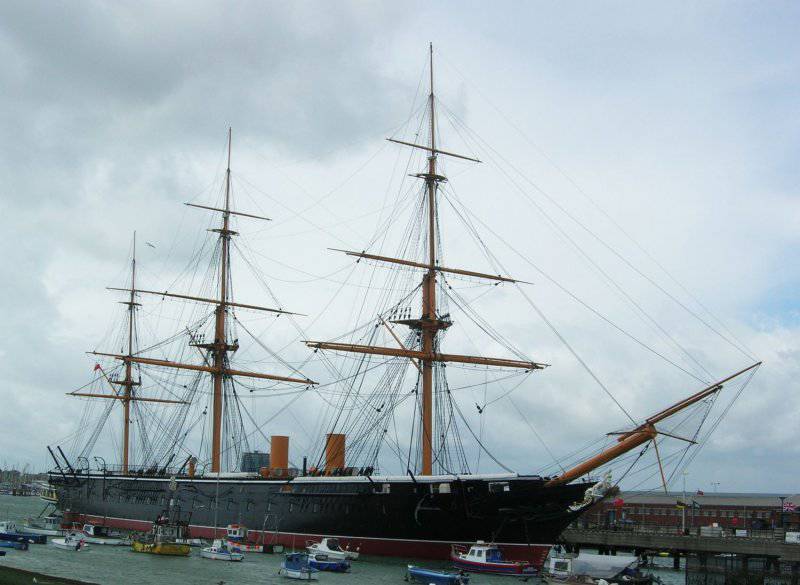
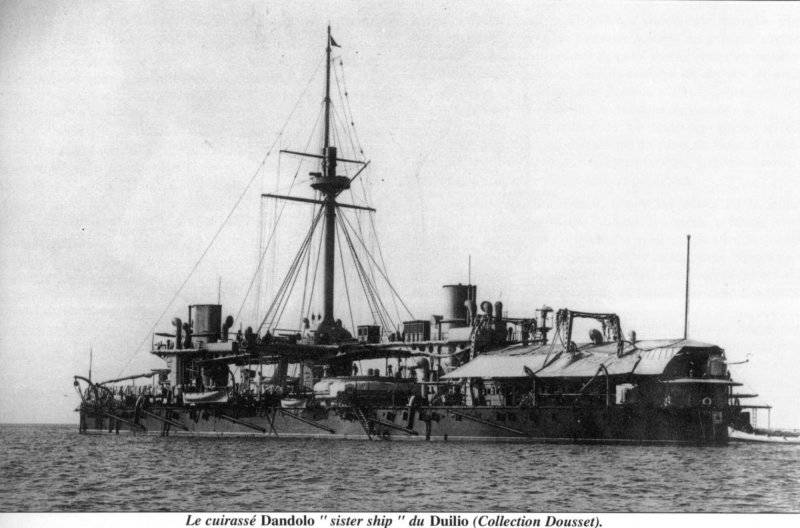
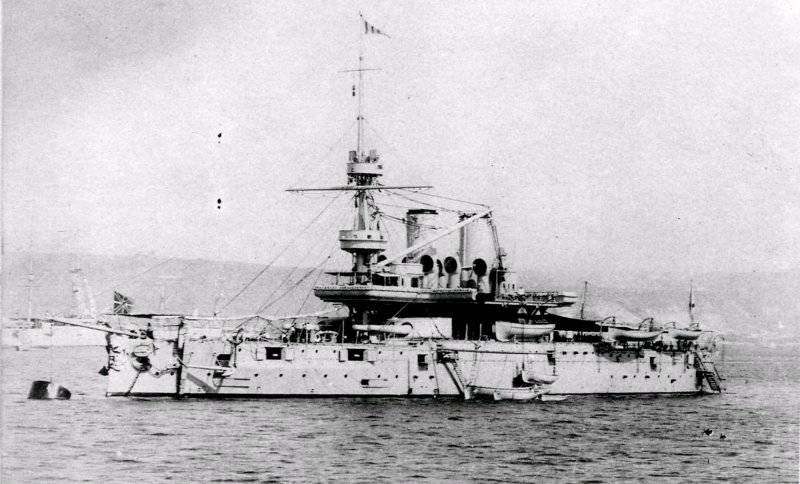
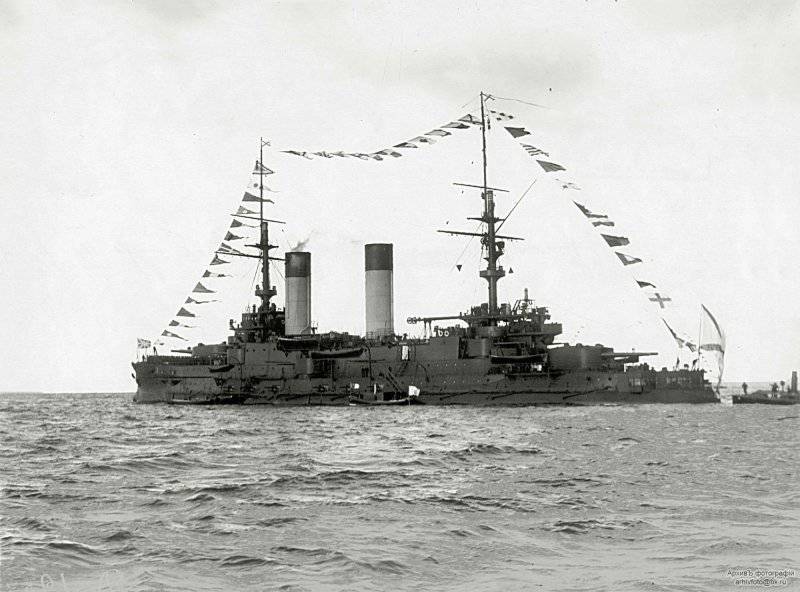
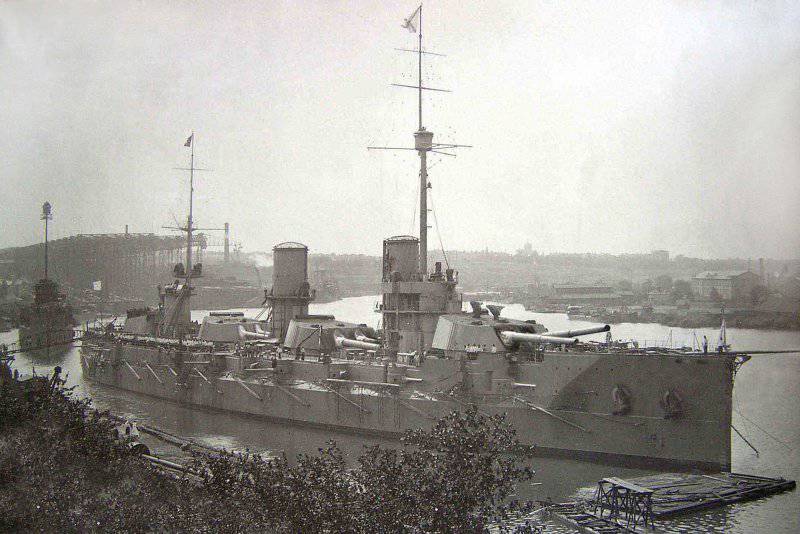
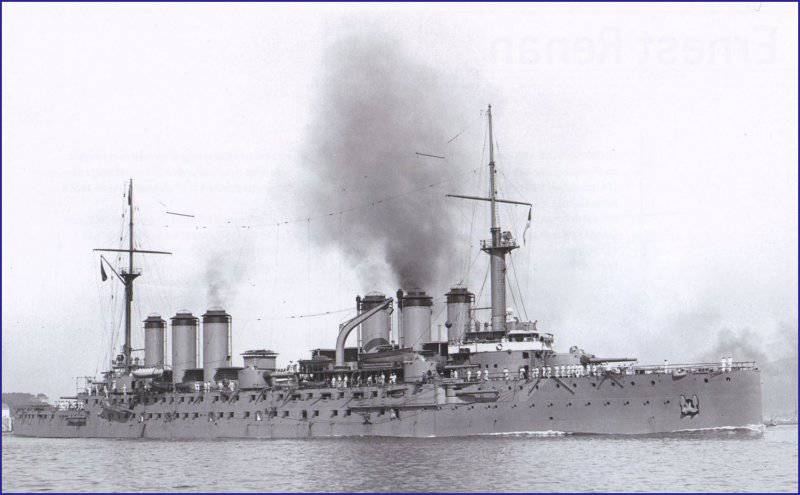
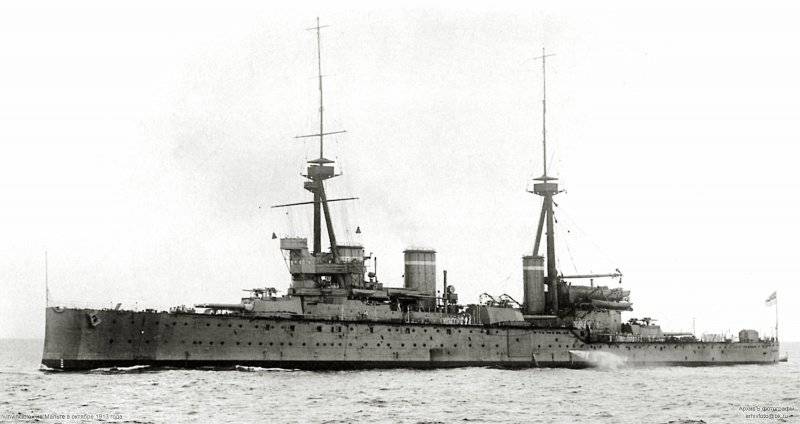
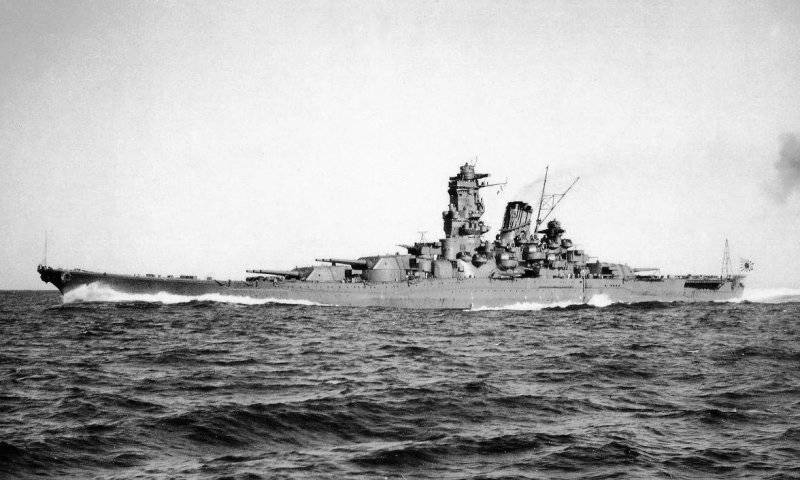
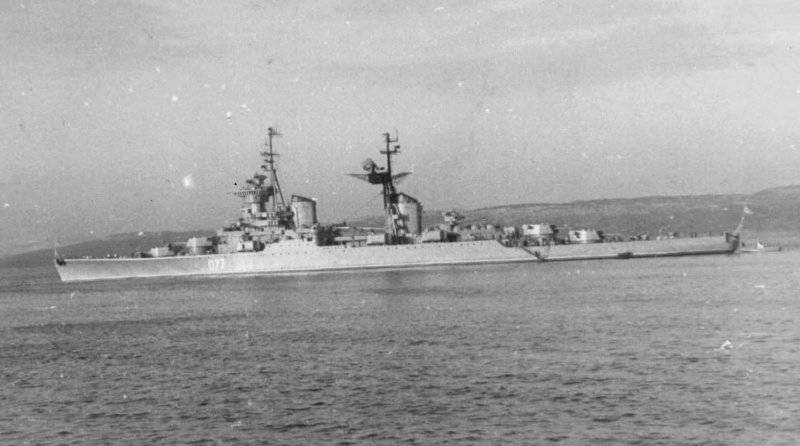
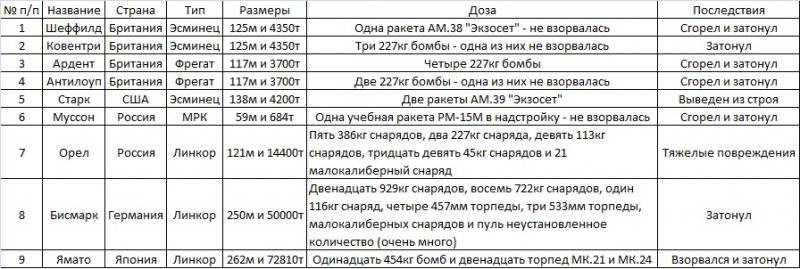
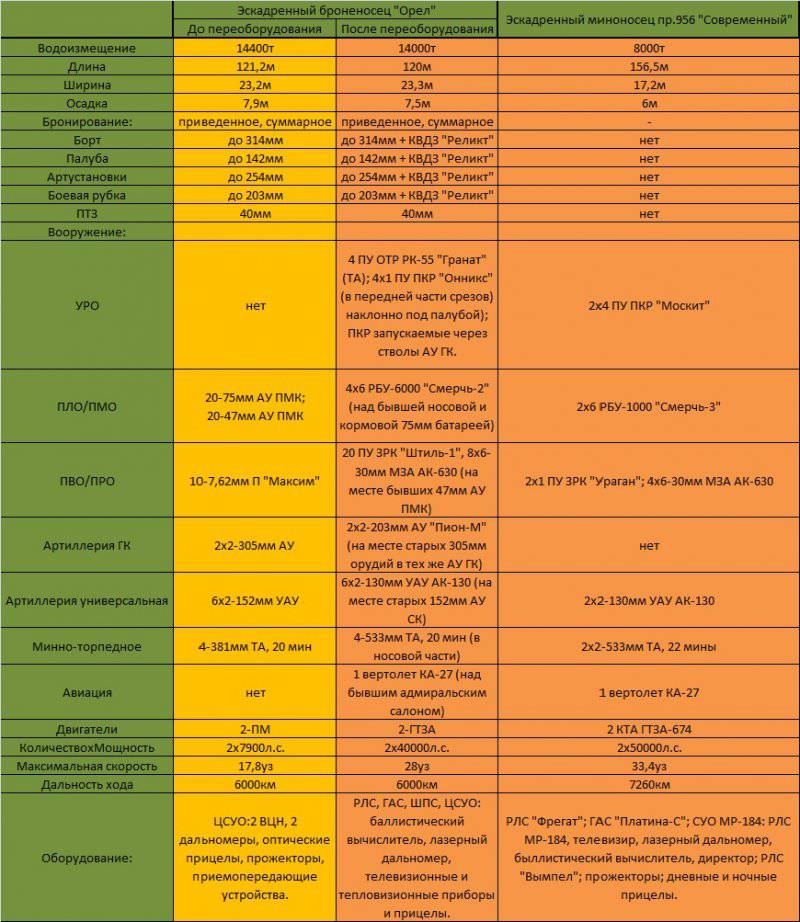
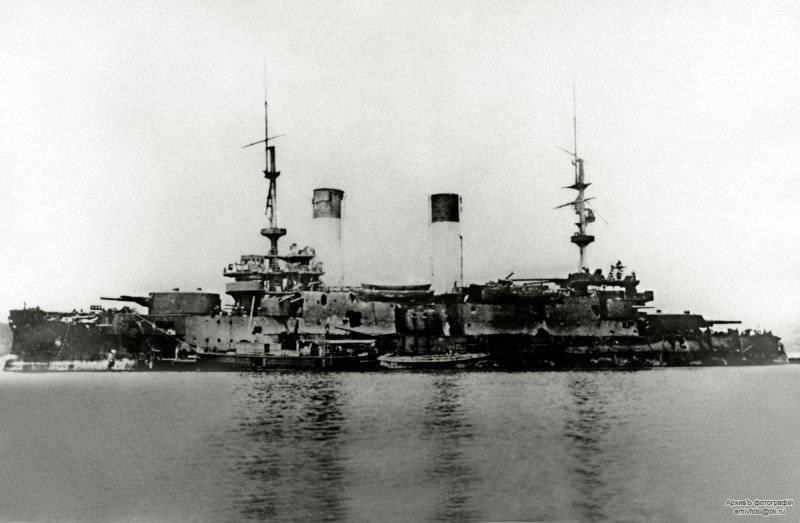
Information